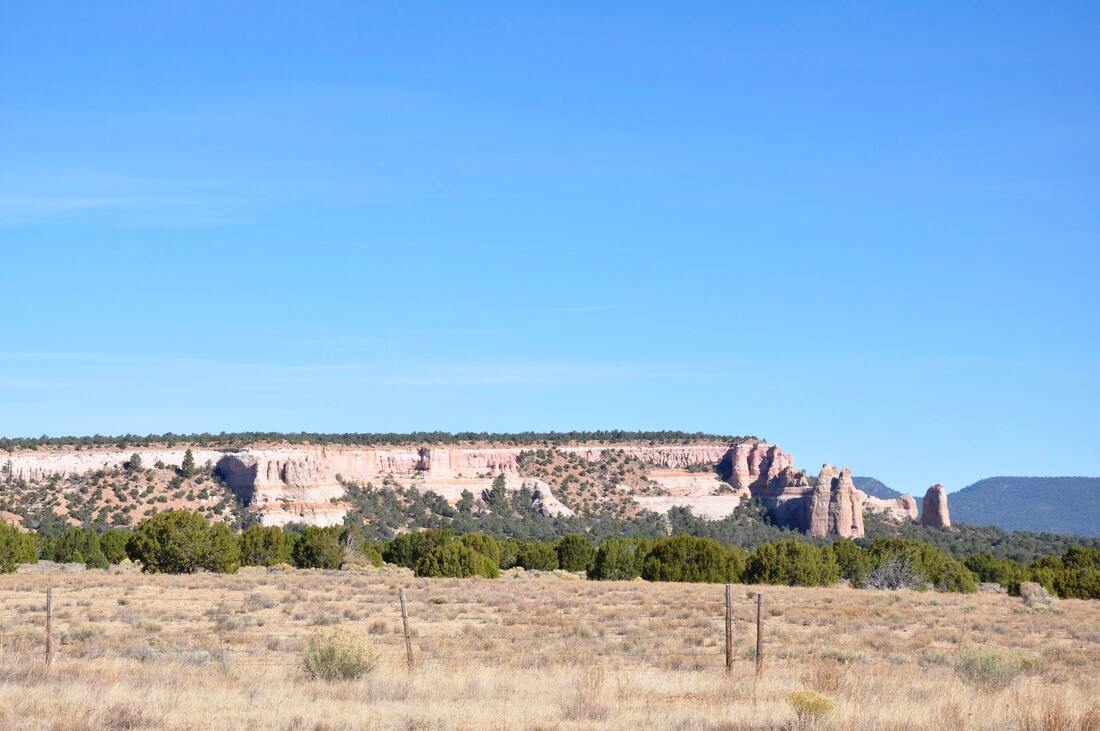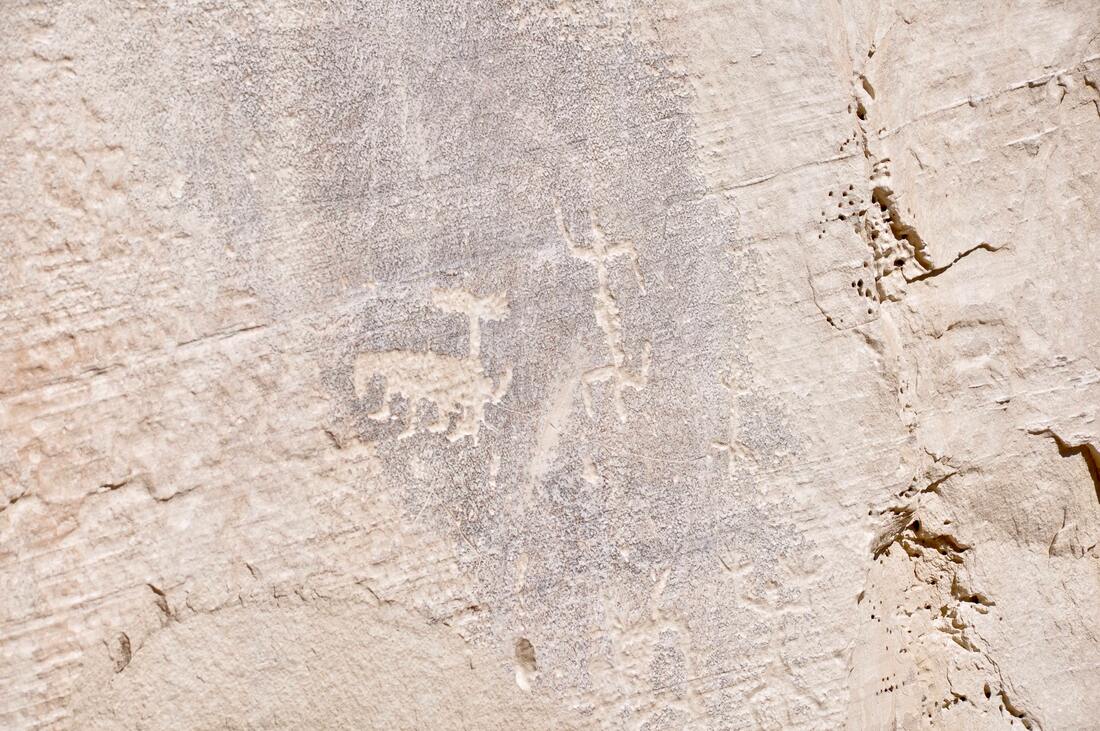|
The Zuni People have a traditional name for the gigantic rock formation that the Spanish called El Morro. The name A’ts’ina translates to “place of writings on the rock” in the Zuni language. The rock in this case refers one that is so large, that it is easy for passers by to spot from miles away. The Spanish name El Morro basically translates to “The Headland” and this in reference to where this landmark is located in the high mesa plains of western New Mexico. Later on in history when the pioneers followed the same old native trails, the name of this natural landmark became known as Inscription Rock. Since the Native Americans, Spanish explorers and European pioneers all left their mark on this gigantic rock, it becomes easy to see that El Morro has plenty of stories to tell! El Morro is a unique site in the fact that this landmark offers a vital resource that is necessary for surviving in a harsh desert climate. El Morro has a natural spring at the base of the tall rock outcrop. The spring feeds a small pond, so there is life giving water available year round. This is why one of the most heavily traversed ancient native trails runs east and west near El Morro. This tall white rock outcrop landmark has always been a watering hole for those who pass through. The water is also the reason why the ancient Pueblo People called El Morro their home. When water was scarce during a drought in the lowlands, it was known that water was available in the high desert at El Morro. This water resource draws wildlife from hundreds of miles around and it was used to irrigate crops, so the natural spring at El Morro was capable of sustaining a sizable population. The gigantic tall rock outcrop eventually became a home for the ancient Pueblo Civilization. High atop the El Morro rock outcrop, out of view from ground level, is one of the largest ancient pueblo complex structures in this entire region of New Mexico. The Atsinna Pueblo at El Morro has over 800 rooms and it was capable of providing shelter for over 1,500 people. The vantage point atop the rock not only created a natural defense for the occupants, it allowed unobstructed views from horizon to horizon, so anyone approaching the watering hole could be seen from miles away. There are two hiking trails at El Morro to choose from. The short Inscription Rock Trail is paved, so those who have mobility challenges can easily access this historic site. The Inscription Rock Trail runs along the base of the big rock past the natural spring to the petroglyph wall. The Mesa Loop Trail is the second hiking trail option and it is an extension of the Inscription Rock Trail. The Mesa Loop Trail is quite a bit more challenging to do. The Mesa Loop zig-zags its way up the steep rock wall to the top. Visitors will find that the mesa top is a totally different world than what can be found at ground level. The path on top of the mesa then winds its way through many interesting rock formations on its way to the Atsinna Pueblo, before zig-zagging downhill back to the visitors center. Viewing El Morro from a distance will provide majestic views, but it is not till a visitor stands at the base of this rock outcrop that one realizes just how genuinely monumental this site really is. Looking up at the top of the sheer vertical rock wall face from below for any period of time is a sure fire way to get a sharp kink in the neck! The first few petroglyphs can be seen next to the small pond the inscriptions will confirm that this ancient place truly has been a cultural monument for a very long time! The hike will slow down to a crawl when entering the petroglyph wall area, because it becomes difficult to take more than a few steps without having to stop to meditate over the meaning of each individual inscription. There are well over 2,000 inscriptions carved into the rock wall by members of many cultures of the past. Hours can be spent interpreting the ancient native petroglyphs that read like a newspaper of events and destinations in the region. One can spend even more time translating the messages that the Spanish explorers left for those who followed back in the 1700s. Visitors can read messages that pioneers left for friends and family that they never thought they would survive to see again. The old cowboy monikers from the late 1800s can be pondered over for quite a spell too. El Morro National Monument is easy to find when driving along old Route 66 (Interstate Highway 40) in western New Mexico. El Morro is located on State Road 53 near the town of Ramah and this road is a scenic alternate route for tourists traveling east or west on I-40. The Zuni Village is also located on State Road 53 just west of El Morro. A visit to the Zuni Village offers a great opportunity to learn a little something from a cultural exchange. The Zuni are renowned for their silver jewelry craftsmanship, so the local village tour option does offer a chance to bring home a valuable conversation piece from the journey. Visiting El Morro certainly is a real pleasure and much can be learned about the history of this region just by reading the inscriptions on this big rock. Standing atop the mesa and taking a deep breath of the clean air while looking far across the desert to the horizon is enough to make oneself want to call this place home, just like so many cultures have done in the past. El Morro truly is a special place that offers a unique experience for all that pass through on the old native trails!
0 Comments
Your comment will be posted after it is approved.
Leave a Reply. |
Leave no trace!
New!
Destination West YouTube channel! https://www.youtube.com/@DestinationWestOrg *The Destination West website upgrading project is well underway. Unique YouTube slideshows are replacing the outdated Flickr photo galleries. The new videos feature modern graphics and alternative music instrumentals that enhance the viewing experience. Some articles are being condensed, while others are getting much needed edits. As everybody knows, the bulk of the original articles and photos were published on the fly during the Covid camping venture and there were limitations. Upgrading is the way to go and more articles will receive a makeover each week until this project is completed. After that, I will be able to gather new material. There is light at the end of the tunnel!
JD Lane Archives
July 2024
Donations help the Destinaton West project continue into the future!
Go Fund Me! This website uses marketing and tracking technologies. Opting out of this will opt you out of all cookies, except for those needed to run the website. Note that some products may not work as well without tracking cookies. Opt Out of Cookies |




















